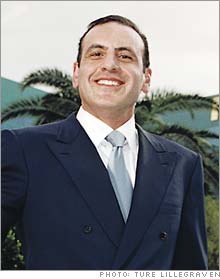|
Going from good to the MGM Grand By ripping out its best-performing venues, Gamal Aziz has reinvented the MGM Grand - and pioneered a radical new growth strategy.
(Business 2.0 Magazine) -- At Las Vegas's Nobhill restaurant, Gamal Aziz is feasting on Tasmanian trout topped with apple-ponzu dressing and basking in the glow of parchment-paper chandeliers. But Aziz remembers this place sporting a very different look - gored concrete walls, disembodied wires - just after he ordered it gutted in 2001. "I walk into a place when I've caused its demolition and it puts me in touch with reality," he says while waiting for a $43 entr�e of Alaskan halibut. "This is what happens when I make decisions."
Those decisions have been hitting the jackpot for the MGM Grand casino resort, the home of Nobhill and the world's largest hotel. The restaurant that formerly occupied Nobhill's space, for instance, had been one of the Grand's top-earning eateries, but the makeover has almost tripled profits. Since taking over as the resort's president in 2001, Aziz has embarked on the service industry's equivalent of Sherman's march, ripping out hundreds of millions of dollars' worth of mostly profitable assets, including over 30 restaurants, bars, and shops, as well as entire hotel wings. The new venues have boosted total sales by more than 25 percent since 2003, making the Grand one of only two casinos (along with the Bellagio) to surpass $1 billion in revenue, while annual operating profit has zoomed up by 45 percent. "Gamal has done the near impossible," says Steve Wynn, a former mentor who owns the competing Wynn Las Vegas. Shaking up a moneymaker Moving forward by working backward Aziz's secret is a counterintuitive management practice - nicknamed "working backward" - that he invented on his arrival at the Grand. The strategy calculates the maximum revenue that each business or space could generate in a perfect world - that is, if every customer spent the most the market could bear and if traffic reached its physical limits. Aziz then subtracts actual sales from that hypothetical number and calls the difference a loss, even if the venue is making money. His formula for closing the gap usually starts with a jackhammer. That's 180 degrees from the way most U.S. companies do things, which is to benchmark based on existing sales: Microsoft (Charts), for instance, is aiming for 12 to 14 percent growth next year on about $44 billion in revenue. Aziz's working-backward epiphany didn't rise out of an MBA path. The 49-year-old earned a bachelor's degree in business at the University of Cairo, in his hometown, and managed restaurants at hotels such as the Plaza in New York. In 1998 he was hired to oversee the food division at Wynn's soon-to-open Bellagio. Determined to transform casino dining from a break-even business into a profit center, Aziz replaced several under-construction eateries with concepts featuring celebrity chefs, an approach soon copied throughout the industry. In late 2000, Aziz was recruited by the MGM Mirage Group (Charts) and soon promoted to head the Grand. Though the resort was the parent company's biggest moneymaker, executives were worried that it could go the way of now-defunct midrange competitors like the Desert Inn. "We were a dormitory," Aziz recalls. "People were sleeping here and going somewhere else to party." He set out to turn the Grand's venues into attractions rather than just functional outlets. His first target was Gatsby's, a restaurant with blue couches, a grand piano, and $2.1 million in annual sales. MGM's board didn't want Aziz to touch it - that is, until he showed them a projection that Gatsby's was "losing" $3 million a year in revenue. Aziz recruited chef Michael Mina, whom he'd brought to the Bellagio, to helm a new restaurant dubbed Nobhill. With Mina's name attached, Nobhill drew more customers, including Bill Clinton and Tiger Woods, paying higher prices. In 2005 the restaurant pulled in $6.5 million in sales, almost a third more than Aziz's projection. Next, Aziz aimed his wrecking ball at the hotel's 29th-floor penthouse, where most of the luxury rooms were given away free to high rollers. The hotel's operations manager figured that, in theory, the rooms could command an average of $1,000 a night. To Aziz, that meant the Grand was squandering $1 million a month in potential revenue. But rather than ask high-net-worth gamblers to pay full retail, Aziz decided to target conventioneers: When a company booked a block of rooms, its C-level executives could stay in the penthouse suites. Last year Aziz converted the floor into a chic hotel-within-a-hotel dubbed Skylofts, pushing the occupancy rate up from 50 percent to 74 percent. Revenue, meanwhile, is up 90 percent. Cutting "losses" Aziz's idiosyncratic practices are beginning to catch on. Former Grand CFO Corey Sanders, who was initially skeptical of the working-backward idea, is conducting similar exercises at 15 of the parent company's 28 casinos. Sister properties, including the Luxor and Mandalay Bay, have raided some of Aziz's working-backward cadres. Over dinner at Craftsteak, another Grand restaurant, Aziz attempts to downplay his radical reputation. "We're not just running around like crazy looking at how much money we're 'losing,'" he insists. Of course, he's saying that in a restaurant whose sales of $16 million are double those of the institution it replaced, the Brown Derby, which had been the Grand's most profitable eatery. There's nothing backward about that. _____________________________ Related: There's no age limit to launching your own start-up. The Art of Shaving's business development strategy. |
|

